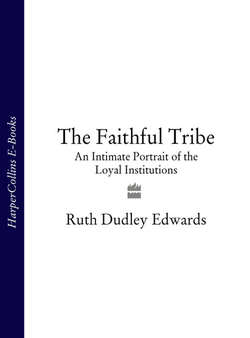Читать книгу The Faithful Tribe: An Intimate Portrait of the Loyal Institutions - Ruth Edwards Dudley - Страница 22
Where lodge meetings are held
ОглавлениеAll over Ulster in villages and in the middle of nowhere there are little Orange Halls built of wood or brick, often with galvanized tin roofs. In Dromore, for instance, Orangemen used to meet in an old army hut that was a rapidly decaying tin shack on wooden stilts. Ulster Protestants are frugal people and the prospect of raising enough money to buy a site and erect a hall was daunting. Alf, the Worshipful Master, decided on drastic action. ‘I said this night, at a lodge meeting: “We must have a hall of our own. I’ll supply the material and I’ll pay the contractor and I’ll get paid some time.” The secretary came in the next morning and he said to me – the only time he ever give me any praise – he says: “Churchill the Second.”’
It took some time to find and buy the right site, and then they built a hall with a stage, which seated about three hundred so it could be used for socials and dances as well as band-practice. It was opened in 1953 in September; in December the north wall of the church collapsed and the church service was held in the hall for three years. Socials ended about twenty years ago; nowadays the hall is a venue for the Duke of Edinburgh’s Award scheme. In the fullness of time, the brethren repaid Alf; building that hall is an achievement which even forty years later he felt was a highlight of his life.
Most halls have been built mostly through jumble sales and sales of work and other unremitting labour by the ladies. Most would be smaller than Alf’s, though large enough to host the dances and conversazioni and teas that made Orange Halls important community centres until the advent of television and other major distractions. The furnishings are of the plainest: mostly wooden benches and trestle tables and the most spartan of spartan fixtures and fittings. There will always be a picture of the Queen and usually some representation of King Billy, and the lodge banner will be displayed on festive occasions.
In towns, the buildings are larger, since they often have to accommodate district or county functions, but austerity remains the norm. Brownlow House, the headquarters of the Royal Black Institution (Orange and Black men often share accommodation), was a fine house until it was torched, though it too was plainly furnished. The two-storey hall at Scarva is as luxurious as it gets, with the stained-glass window featuring King Billy, a spacious assembly-room and portraits and prints of Orange significance.
A 1960s building, the tall, narrow Orange HQ at 65 Dublin Road, Belfast, sets the tone for the whole organization. There are a few adornments, including a portrait of the Reverend Martin Smyth, ??, Grand Master for a quarter of a century, and some William-related pictures. A small room contains an interesting hotch-potch of archives, books and memorabilia, but for the most part the building consists of spartan offices.*
